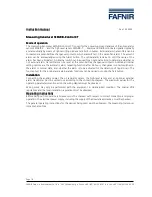
7
dPMR™ OPERATION
7-18
The Trunking mode enables the transceiver to move
to another site, according to the preset Short Hunt
list*
1
, in order to fi nd a site that has a higher quality
signal, or provides better services�
The Roaming function is automatically activated when
the transceiver goes out of the service range, and
does not receive the downlink signal from the repeater
in the currently registered site�
Depending on the presettings, the transceiver tries to
register to the repeater that has the strongest RSSI
level in the last registered site or an adjacent site�
This roaming type takes more time than other roaming
types�
The transceiver displays the channel text after the
registration is complete�*
2
The transceiver displays “Out of Range” when
the transceiver cannot register to any site after
searching�*
2
*
1
The valid roaming areas (up to 100) are listed on the
Short Hunt list�
*
2
Only for the Portable Ten-key and Simple key types and
the Mobile LCD types�
D
Roaming Request function
The Roaming Request function enables the
transceiver to start or resume a Roaming scan,
regardless of the error rate�
L
Even if the Site Lock function is ON, and the transceiver
is locked to the currently registered site, pushing
[Roaming Request] resumes a Roaming scan�
<Menu operation>
Portable:
For the Ten-key and the Simple key types
Mobile:
For the LCD types
(Menu > Trunking >
Roaming Request
)
1� Push [Menu] to display the Menu screen�
2� Push [Left] or [Right] to select “Trunking,” then
push [OK]�
3� Push [Up] or [Down] to select “Roaming Request,”
then push [OK] to start or resume the Roaming
scan�
<Key operation>
Push [Roaming Request] to start or resume the
Roaming scan�
Roaming function (For the Trunking operation)
















































